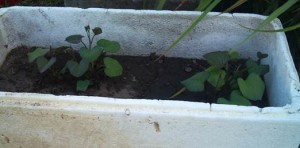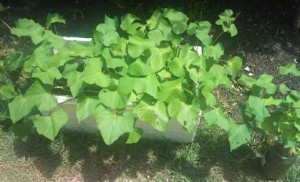For quite a while I avoided growing sweet potatoes. It seemed too much like hard work. First you had to get a sweet potatoe to shoot vines and them you had to take the vines off and plant them.
After getting on to YouTube and seeing how you get the vines (called slips) to grow, I decided to have a go and see what turned out.
Once you have sweet potatoes in the ground, unless you are pretty careful, you will have them for life. They are like a weed and will take over the place. It would be pretty difficult not to get a crop. I have beans where the sweet potatoes were and am still pulling out vines shooting through the soil. Admittedly I am talking about the gold or orange coloured ones. I didn’t have as much success with the purple ones. Got more vine than potatoe.
The following paragraph is from Wikipedia http://en.wikipedia.org/wiki/Sweet_potato
The plant is a herbaceous perennial vine, bearing alternate heart-shaped or palmately lobedleaves and medium-sized sympetalous flowers. The edible tuberous root is long and tapered, with a smooth skin whose color ranges between yellow, orange, red, brown, purple, and beige. Its flesh ranges from beige through white, red, pink, violet, yellow, orange, and purple. Sweet potato varieties with white or pale yellow flesh are less sweet and moist than those with red, pink or orange flesh
Growing the slips
As with most things tried for the first time, I tend to take too much care of the plant. With sweet potatoes they are bloody near impossible to kill, no matter how poorly you look after them. The easiest way I found was to throw some soil into a styrofoam box with a couple of drainage holes in the bottom. Water and wait for the slips to appear. I tried another way with the tuber suspended in a jar of water, but the ones in the dirt grew much quicker. Slips from both were planted and both ways produced a great harvest.
Finding a Source of Slips
The easiest way to start some slips is to buy a couple of Organic sweet potatoes. The ones in the supermarket have an inhibitor sprayed on them to stop them growing. The organic ones will start gowing slips all by themselves when the temperature starts to warm and the hours of daylight increase toward spring, depending on temperature. In that way they are similar to potatoes.
Planting Out
When planting, it is better to pull the slips off the potatoe and plant them in the soil. In the bed I grew the tubers grew vertically down into the soil and the vines wanted to take over the rest of the garden. The garden bed was dug
over pretty well and there was a fair bit of compost dug in. At least four times during the growing period, about 6 months where I am, I got out the hedge clippers and cut back the vines.
Harvesting
I found the easiest way to harvest was to pull up the vine and find where the tubers were. The vine leads back to the tuber where there were between 4 – 8 tubers. Some of the tubers were quite big and weighed over 2kg each. The majority were around 400 (1lb) to 800gms (2lb). The harvest was in excess of 150kg and the neighbours and friends were well supplied.
I still have about 40kg of sweet potatoes stored in the shed and it is now the middle of winter and 3 months after harvesting them. They go well in the slow cooker in a beef casserole and make a great sweet when cooked very slowly for a couple of hours in a sugar syrup.
And they make great chips. Cut thinly, put a small amount of olive oil in a baking dish, rub the slices in the oil. Grind some rock or sea salt over and bake in the oven for around an hour at about 200C. You need to check every now and then, move them around a bit and rotate the dish and ensure they don’t burn. You just want them crisp.




